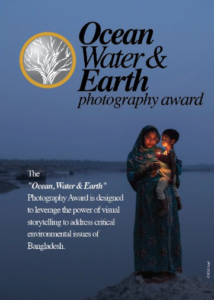
Marine Litter News | December 2022
Microplastic, Cosmetics, and Our Responsibilities : Download the PDF
Microplastic, Cosmetics and Our Responsibilities
We don’t need to introduce you all to the word microplastic. In the preceding decade, microplastic was one of the most talked about words in the world. Since microplastic can often be less than 5 millimeters, it can be minuscule, microscopic, and practically invisible. No artificial substance is more dangerous than which we intrinsically connect in our daily life.
We either do not know or do not understand that this is true, or even if we know, the microplastic size is so small that we tend to ignore it. Microplastic is just a fragment of any kind of plastic. It could be any plastic whatsoever. Any substance that has a physical form and is built with plastic compounds or polymers, all fragments of that substance will exhibit fundamental properties of that plastic. Irrespective of how small the plastic is or what name is given to it, it remains, in the end, plastic.
According to popular notion, when larger plastics disintegrate or their constant breakdown results in their reduction, microplastic is only formed. It is not true that microplastic can be created only after disintegration. Our overall social image of microplastic is not wrong but perhaps quite inadequate. The usage of microplastic can be seen in all the products of our daily use, and we are often unaware of it. A simple example is that of cosmetics/beauty products.
Every year about 3,800 tons of microplastic are released into the environment, and it comes only from the cosmetic products we use daily. This statistical data has been received from Europe only. Although there are specific international parameters or guidelines for plastic use, it is now a proven truth that cosmetic goods have plastic (synthetic polymer), irrespective of the name it exists as1, 2. Our civilization is heavily plastic-dependent. Plastics are present in products ranging from cosmetics and paints tomedicines and producers of agricultural goods. From these kinds of goods, Countries from European Union alone produce nearly 42,000 tones of plastic-based pollutants in microplastic form every year3. Once this microplastic produced from common goods used in our daily life is mixed with the environment, no mechanism has been discovered to date to collect them back.
In some cases, certain cosmetic goods have in their constituents nearly 90% of synthetic polymer, plastic polymer, or simply plastic4. Once the tiny or microscopic components of these cosmetic goods are used, it goes through the process of washing, from our bathrooms, toilets, rivers, canals, and ponds (where the washing happens) to the processing of sewage systems. The amount of plastic-like elements present in this product4 will equal the amount of plastic-like elements that will be added to the environment. If it is possible to purify the water in water treatment plants, the residue left after purification is mostly let to be mixed with the soil. But it is not like these treatment plants are not useful at all.
Cosmetics manufacturing companies do not list plastic as an ingredient used in their showroom products. They list ingredients in the names of water-soluble polymer/WSP, liquid, semi-solid, biodegradable, etc. All of these are artificial or engineered nano-plastics. It remains plastic even when sieved through standards of regulations for the ease of enterprises.
Water soluble polymers can be defined as a kind of plastic that dissolves in water. And due to this, it is used in different types of cosmetics, paints, building materials, agricultural products, etc. Polyvinyl alcohol is another kind of water-soluble polymer manufactured the most in the world in the past century and the most frequently used too –5 650,000 tons per year [6].
It is said that these water-soluble polymers dissolve in water completely, but there’s a catch in the story. When the density of polymers increases, the tendency to dissolve decreases. It is further complicated when a distinct amount of catalyst is required for the dissolution. For example, a particular amount of humidity, certain kinds of microorganisms, and a specific amount of time and temperature all influence the dissolution process. The time taken can be altered if the water-soluble polymer is passed through a water treatment plant. Even if that happens, the exact number of controlling criteria needed for all of it to dissolve completely in water is impossible to achieve outside a laboratory setting. These facts show that no matter what is said, a more significant part of the plastic polymers released from water-soluble polymers would eventually end up in the environment [7].
Certain studies have revealed that out of ten cosmetics in the market, microplastic can be found in nine, but it is not listed in the list of ingredients used in that particular product8. These studies have been conducted on products from the European market. At the same time, out of the 144 products taken from the Asian market, 68 products were for the body, 31 were for use on the face, and the others were different cosmetics. The results of this study have shown the discharge of microplastic in the environment2.
There are numerous other such examples, and they will always be. But the truth is presented to us as a half-truth – no company explicitly mentions whether or not the products we use every day have plastic in them. It is challenging for commoners like us to understand the intricacies of scientific explanations. Is anyone simply telling us, ‘What you’re putting on your face doesn’t contain any plastic?’ People who are producing these goods are also greenwashing9 us.
They are telling us that this is good, use it. They say this is eco-friendly, and we swarm to buy it.
But what is to be done about it? Just like everyone else, you and I are also concerned about this planet earth. And this is no exaggeration. We feel pity in our ways: maybe we become dazed with guilt. But what is to be done? We cannot stop beautifying ourselves everyday. Everyone wants to appear beautiful in front of themselves or front of others. But let us be attractive for the sake of our planet, at least for a day. Be it in a week, a month, or a year. Let us be beautiful without using harmful plastic cosmetics.
1 Assessment of Toxicity and Biodegradability of Poly (vinyl alcohol)-Based Materials in Marine Water Olalla Alonso-Lpez, Sara Lpez-Ibez, and Ricardo Beiras
2 Personal Care and Cosmetic Products as a Potential Source of Environmental Contamination by Microplastics in a Densely Populated Asian City Saidu M.
Bashir, Sam Kimiko, Chu-Wa Mak, James Kar-Hei Fang and David Gonalves
3 ECHA. Microplastics, under “What are the concerns?” (n.d.). Helsinki: European Chemicals Agency. Accessed: February 2022. Available at:
https://echa.europa.eu/hot-topics/microplastics.
4 Leslie, H. A. Review of microplastics in cosmetics: Scientific background on a potential source of plastic particulate marine litter to support decision-making
(2014). Amsterdam: Vrije Universiteit. Accessed: February 2022. Available at: https://research.vu.nl/en/publications/review-of-microplastics-in-cosmeticsscientific-
background-on-a-p.
5 Chiellini, E.; Corti, A.; Solaro, R. Biodegradation of Poly(Vinyl Alcohol) Based Blown Films under Different Environmental Conditions. Polym. Degrad. Stab.
1999, 64, 305–312.
6 Xu, S.; Malik, M.A.; Qi, Z.; Huang, B.T.; Li, Q.; Sarkar, M. Influence of the PVA Fibers and SiO2 NPs on the Structural Properties of Fly Ash Based Sustainable
Geopolymer. Constr. Build. Mater. 2018, 164, 238–245.
7 Arp, H. P. H. & Knutsen, H. ‘Could We Spare a Moment of the Spotlight for Persistent, Water-Soluble Polymers?’ (2019). In Environmental Science & Technology
54(1), 3–5.
8 Statista. Leading 20 health and beauty brands ranked by consumer reach points in Europe in 2020 (May 2021). Accessed: February 2022. Available at:
https://www.statista.com/statistics/900345/most-chosen-health-and-beauty-brands-europe/.
9 https://en.wikipedia.org/wiki/Greenwashing








